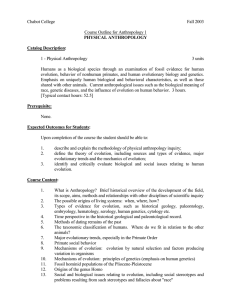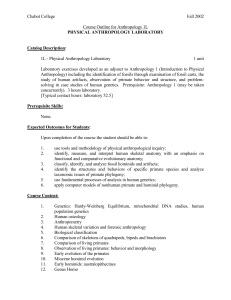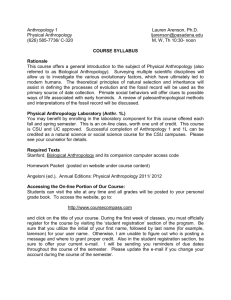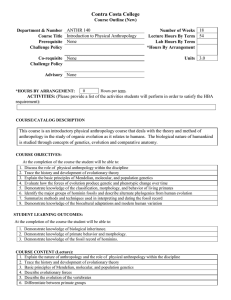Chabot College
advertisement
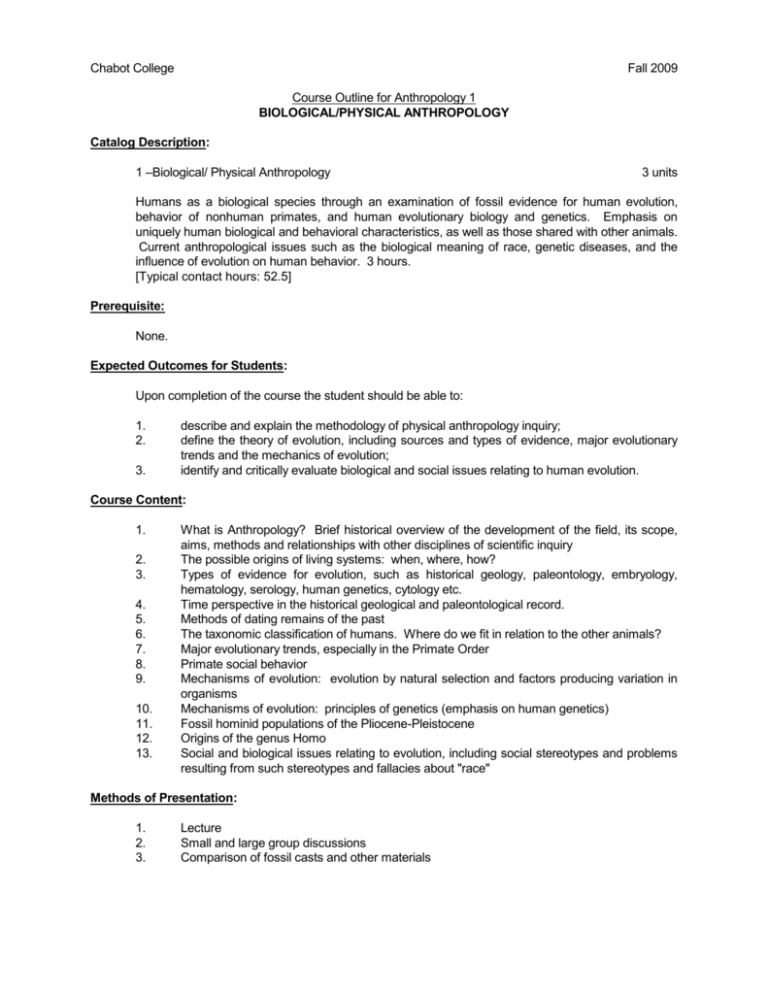
Chabot College Fall 2009 Course Outline for Anthropology 1 BIOLOGICAL/PHYSICAL ANTHROPOLOGY Catalog Description: 1 –Biological/ Physical Anthropology 3 units Humans as a biological species through an examination of fossil evidence for human evolution, behavior of nonhuman primates, and human evolutionary biology and genetics. Emphasis on uniquely human biological and behavioral characteristics, as well as those shared with other animals. Current anthropological issues such as the biological meaning of race, genetic diseases, and the influence of evolution on human behavior. 3 hours. [Typical contact hours: 52.5] Prerequisite: None. Expected Outcomes for Students: Upon completion of the course the student should be able to: 1. 2. 3. describe and explain the methodology of physical anthropology inquiry; define the theory of evolution, including sources and types of evidence, major evolutionary trends and the mechanics of evolution; identify and critically evaluate biological and social issues relating to human evolution. Course Content: 1. 2. 3. 4. 5. 6. 7. 8. 9. 10. 11. 12. 13. What is Anthropology? Brief historical overview of the development of the field, its scope, aims, methods and relationships with other disciplines of scientific inquiry The possible origins of living systems: when, where, how? Types of evidence for evolution, such as historical geology, paleontology, embryology, hematology, serology, human genetics, cytology etc. Time perspective in the historical geological and paleontological record. Methods of dating remains of the past The taxonomic classification of humans. Where do we fit in relation to the other animals? Major evolutionary trends, especially in the Primate Order Primate social behavior Mechanisms of evolution: evolution by natural selection and factors producing variation in organisms Mechanisms of evolution: principles of genetics (emphasis on human genetics) Fossil hominid populations of the Pliocene-Pleistocene Origins of the genus Homo Social and biological issues relating to evolution, including social stereotypes and problems resulting from such stereotypes and fallacies about "race" Methods of Presentation: 1. 2. 3. Lecture Small and large group discussions Comparison of fossil casts and other materials Chabot College Course Outline for Anthropology 1 Fall 2009 Page 2 Assignments and Method of Evaluating Student Progress: 1. Typical Assignments a. Observe, record, and analyze primate social behavior at the Oakland or San Francisco Zoo. b. Write essays on current topics in physical anthropology. 2. Methods of Evaluating Student Progress: a. Midterm Examinations b. Individual and/or group projects c. Essays d. Final Examination Textbook(s) (Typical): Core Concepts in Biological Anthropology, Augustin Fuentes, McGraw-Hill, 2006. Annual Editions: Physical Anthropology, Dushkin Publishing Group, 2006. Special Student Material: None.
